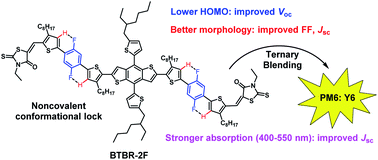Achieving 17.38% efficiency of ternary organic solar cells enabled by a large-bandgap donor with noncovalent conformational locking†
Abstract
A large-bandgap donor, BTBR-2F, based on noncovalent conformational locking has been designed and synthesized to achieve more complementary absorption with a PM6:Y6 blend in the near-ultraviolet region. The ternary blend film with 20% BTBR-2F achieves the best morphology with a nanofibrous network structure and small domain size, which results in the most efficient exciton dissociation, highest charge mobilities, and lowest charge recombination. Moreover, BTBR-2F possesses lower HOMO and LUMO energy levels than PM6, which leads to more efficient energy/charge transfer and higher Voc in ternary OSCs. Therefore, the ternary device with 20% BTBR-2F achieves the highest efficiency of 17.38%, with a Voc of 0.859 V, Jsc of 27.30 mA cm−2, and FF of 74.11%. The study presents an efficient noncovalent conformational locking strategy to tune the energy levels, absorption band and molecular aggregation of a small molecular donor for high-performance ternary organic solar cells with comprehensively improved photovoltaic parameters.



 Please wait while we load your content...
Please wait while we load your content...